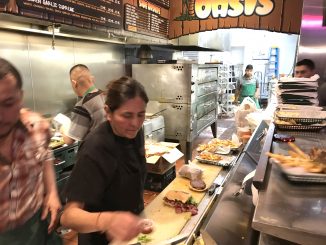
OPINION
BY DAVE PRICE
Daily Post Editor
The closing of the Oasis Beer Garden in Menlo Park has been puzzling.
We all know it was because of a lease dispute between the owners, the Beltramo family, and the business operators, the Tougas family. The Tougases ran the pizza, burger and beer joint for 60 years.
Before they closed on March 7, the Tougas family said in a statement that they were “unable to negotiate a reasonable lease for our business nor meet the requested terms of the building’s owner.”
The Beltramos said they were sorry to see the place close and that they were interested in finding a new operator for the restaurant at 241 El Camino Real.
An attempt by the operators of the Dutch Goose to negotiate a deal to run the Oasis fell through, according to City Councilman Ray Mueller, who was trying to find a way to reopen the Oasis. Why such a deal fell through is a mystery because the two parties are well known to one another. The Beltramos family is the landlord of the Dutch Goose at Avy Avenue and Alameda de las Pulgas in west Menlo Park.
Redevelopment?
Do the Beltramos want to redevelop the Oasis, as many have speculated? While the city planning department has fielded some inquiries about the property, no application for a new development has been submitted. And it looks like the city is going to slap a historic designation on the property since the building dates back 100 years and was originally part of Camp Fremont, a training barracks for World War I troops in Menlo Park. A historic designation could possibly limit redevelopment options.
If the lease negotiations with the Tougas family broke down over a demand for more money — and I don’t know that to be a fact — the result is that the Beltramos are not making any money now from an empty building.
Getting something is better than getting nothing.
And the Beltramos have another problem — it’s never easy for a landlord to land a successful restaurant.
Restaurant failure rates
You’ve probably heard the statistic that 90% of restaurants fail in their first year. That isn’t quite true. I looked at a couple of studies. One (by researchers from UC-Berkeley and the U.S. Bureau of Labor Statistics) said the first-year failure rate was 17% while another (by Ohio State University) said it was 60%.
Whatever statistic you believe, the key to success for the landlord is to find a well-capitalized, experienced operator. That’s not easy to find.
There are other reasons why a lease negotiation could have failed. For instance, what if the landlord demanded that the tenant make improvements to the premises, and the tenant either couldn’t or wouldn’t pay for them? Or visa versa?
I’m not saying that happened, but it’s not uncommon for tenant improvements to become a sticking point in commercial lease negotiations.
Readers have repeatedly asked that we print the Oasis’ rental rate and what the Beltramos were seeking from the Tougases in the new lease.
But these are private businesses. They don’t have to reveal that information to anybody.
So we’re all left wondering why a 60-year business that appeared to be wildly successful has closed. As I said, this is puzzling.
Editor Dave Price’s column appears on Mondays. His email address is [email protected].



You left one thing out–how the second generation of Beltramos wanted more money from the restaurant than their parents. In other words, greed. One generation created wealth and the next wants to live off of that wealth. Now, as you’ve said, they’re getting nothing. Just deserts.
The Menlo Park City Council should designate this building as a historical landmark. This could stop demolition of the building and possibly cause the owners to bring back the Oasis.
Dave, you assume the Tougas family ran a “successful” operation. They operate a number of restaurants, so the success of one individual location may not be clear. Most of their other restaurants are in lower-rent areas in the south bay.
FWIW, The Oasis’ type of business (cheap beer and burgers) may not generate enough revenue to either pay more rent or pay for improvements to the kitchen or bar that would increase overall revenue. In this case, there isn’t a fit for either operator or landlord. The idea that you hold onto a tenant with a model that limits any long-term investment is actually a slow-burn failure. In that case, the landlord simply needs a different operator in place.
This may not be the reason, and makes for less conspiratorial “fun”- but this represents the reality of restaurants.
We keep losing old, well known, popular restaurants. It may be “progress” or the reality of the market, but it still sucks. Depot Cafe and Oasis are examples of what appears to be landlords who see no value in keeping old businesses in place. It will probably become just another Starbucks, or Taco place, or frozen yogurt, etc.